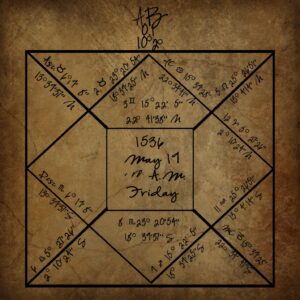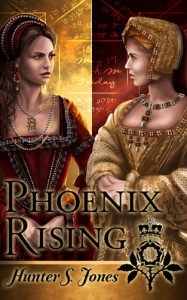 A big welcome to Hunter S. Jones who is celebrating the forthcoming launch of her novel Phoenix Rising: A Novel of Anne Boleyn by visiting is today with a guest article on Tudor medicine and magic. Over to Hunter…
A big welcome to Hunter S. Jones who is celebrating the forthcoming launch of her novel Phoenix Rising: A Novel of Anne Boleyn by visiting is today with a guest article on Tudor medicine and magic. Over to Hunter…
The medical arts were vastly different in the Tudor era than they are today. There was a limited amount known about the causes and cures for disease at that time. There was limited knowledge with regards to how the human body functioned. Due to religious practices of the time, it was unheard of to dissect a human body following death. Tudor physicians thought the body was made up of four fluids or ‘humours’. The humors were blood, phlegm, choler (yellow bile), and melancholy (black bile). In a healthy person of the Tudor era, all four humours were considered to be balanced. However, if you had too much of one of the humours, the body was out of balance and illness manifested.
Here are a few examples of the Tudor healing arts. If a person had too much blood they would be bled by applying leeches to the skin or by cutting a vein. Generally people were bled at each solstice and equinox, in order to keep them in alignment with the elements (earth, wind, fire and air) and the seasonal changes. Tudor doctors also thought infectious diseases, like the plague or the sweating sickness, were caused by poisonous, airborne vapours, which were absorbed through the skin. An imbalance of the other humors would be treated by adjusting the patient’s diet – by taking medicines to purge the body of the vile humours. You get the basic tenet of medicine from these remedies and the art of Tudor medicine. The mystery begins to reveal itself.
Now, let’s take a glimpse at some of the secrets behind my story, Phoenix Rising. As we can see, astrology had an important placement in Tudor life as well as Tudor medicine. Physicians believed that different signs of the zodiac ruled each parts of the body. This is where the magic of my story begins.
According to Dr. Elizabeth T. Hurren of Oxford Brookes University:
“Physicians were trained in all the intellectual refinements. They studied astronomy, astrology, geometry, mathematics, music and philosophy. They provided a holistic approach, treating a patient’s mental, moral and physical needs. They believed that a sickness or canker’s root cause might be in the mind, the organs or the human spirit. Fate, fortune and goodwill might cure when a physic (physician) failed. The Tudors believed strongly in a divine plan in the face of providence. That life was “God given” and could also be “God taken”. From birth, Henry’s astrological lore was minutely examined. Born under the sign of Cancer (28 June 1491), he was governed by the watery and maternal cycles of the moon.”
The mystery began as I researched the medicine of the era. Herbs were the best known cure for any sickness. Herbs have been used as cures since ancient times. It was part of the education of any physician. Also, young Tudor women learned to mix potions, or ‘simples’ as they were called. These women would have great expertise in the healing properties of different herbs. As a general rule, the wise women were taught with traditions handed down from their mothers and grandmothers. Herbs and the healing chants of the wise woman were the most cost effective medical route for the majority of Tudor households. One Tudor headache cure for a headache was to drink a potion of lavender, sage, majoram, roses and rue. Another cure? To press a hangman’s rope to your head.
The physicians, then as now, were considered the most learned scholars. That’s where astrology comes into play. In Tudor times, astrology was considered a science. It was considered the most exact science since it revealed the planets as they circled the earth. During the Tudor era, it was believed that the sun, moon and planets circled the earth. With that in mind, the King was the centre of their universe. When Henry VIII was ill, his physicians treated him with herbs, he even kept an apothecary cabinet in his quarters. Astrology charts, or star maps as they were known then, would be drawn to decipher the best medical treatment for his leg or his various other ailments.
Henry’s grandmother and his father (Lady Margaret Beaufort and King Henry VII) were devout Catholics, yet they were highly superstitious. Both kept a retinue of soothsayers and diviners in their employment, along with their physicians. They aimed to be of one accord with the planets and signs from the heavens. Elizabeth I even chose the exact moment of her coronation based on an astrology chart drawn by her physician John Dee. The Tudors believed that “as above, so below”. If the royal humors were balanced within the body, their body would be in tune with the heavenly realm.
From all the aforementioned, I developed the story which is Phoenix Rising. It is the story of the last hour of Anne Boleyn, as told from the descendant of the astrologer/physician to King Henry VIII. She uses the antiquarian ‘star map’ used by her ancestress, Milady Bliant, to reveal the stories hidden within that hour. Milady Bliant, a Welsh healer whose family has a longstanding placement with King Henry’s family, is the person the King trusts to find the exact time for the execution of Anne Boleyn, as interpreted by a star map.
Characters include King Henry VIII, Anne Boleyn, Jane Seymour, Sir Francis Bryan, Thomas Cromwell, Ralph Sadler, Mary Tudor, Eustace Chapuys, Elizabeth Howard Boleyn, Elizabeth I and the Swordsman of Calais.

Look for upcoming insights into the secrets of Tudor England’s medicine and magic as we move closer to the May 19 launch date. Phoenix Rising can be pre-ordered today at getBook.at/phoenix_rising.
Phoenix Rising: A Novel of Anne Boleyn
 The last hour of Anne Boleyn’s life…
The last hour of Anne Boleyn’s life…
Court intrigue, revenge and all the secrets of the last hour are revealed as one queen falls and another rises to take her place on destiny’s stage.
A young Anne Boleyn arrives at the court of King Henry VIII. She is to be presented at the Shrovetide pageant, le Château Vert. The young and ambitious Anne has no idea that a chance encounter before the pageant will lead to her capturing the heart of the king. What begins as a distraction becomes his obsession and leads to her destruction.
Love, hate, loyalty and betrayal come together in a single dramatic moment… the execution of a queen. The history of England will be changed for ever.
Praise for Phoenix Rising:
“Compelling, captivating and moving.” Claire Ridgway, The Anne Boleyn Files
“Thought provoking, esoteric and heart wrenching.” – R.J.Askew, blogger, reviewer, author and journalist.
Deb Hunter publishes as Hunter S. Jones. Her best-selling novel, “September Ends” won awards for Best Independently Published Novel and Best Romance, based on its unique blending of poetry and prose. Her story “The Fortune Series” received best-selling status on Amazon in the Cultural Heritage and Historical Fiction categories. She has been published by H3O Eco mag, LuxeCrush, Chattanooga Times-Free Press, and is now a freelance contributor for the Atlanta Journal Constitution. She has recently been accepted into the prestigious Rivendell Writers Colony. Her arts, music and culture blogs on ExpatsPost.com are filled with eclectic stories regarding music, writing, the arts and climate awareness. She lives in Atlanta, Georgia with her Scottish born husband. Her undergraduate degree is in History with an emphasis on the English Renaissance and Reformation.
The Kindle version of Phoenix Rising can be pre-ordered today at getBook.at/phoenix_rising for delivery on 19th May and the paperback will be available to order on 19th May.
Notes and Sources
- Star map concept and design is my own creation; artwork by LLPix
- Oxford University, Bodlein Library and Radcliffe Camera. http://www.bodleian.ox.ac.uk/bodley. Special thanks to this site for allowing glimpses into the astrological charts compiled by the Elizabethan astrologers/physicians, John Dee and Simon Forman.
- “Tudor Medicine”. HistoryLearningSite.co.uk.
- “King Henry VIII’s Medical World” by Dr. Elizabeth T Hurren, Senior Lecturer History of Medicine at Oxford Brookes University.
- “Medicine and Doctors in Tudor England” by Tim Lambert.
You can learn more about Tudor medicine from Historic Royal Palaces – https://youtu.be/3AoMvpA8JPc.